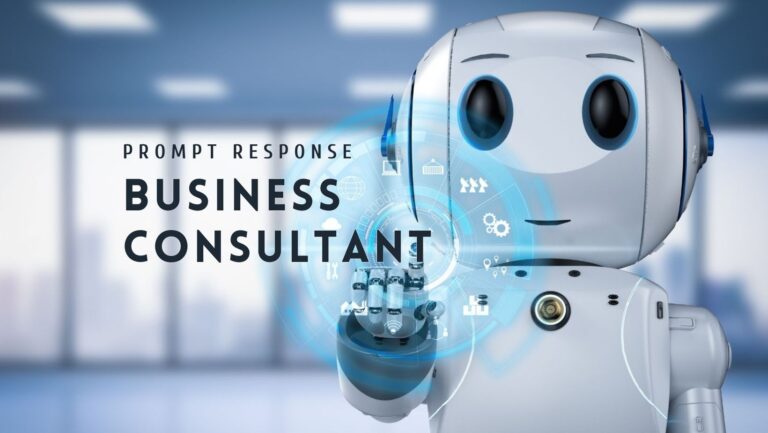AI Prompt Generator: Tips To Master the Art of Generative Text AI

In the digital landscape, the power of artificial intelligence (AI) is transforming the way we communicate, create, and consume content.
From chatbots to sophisticated language models, AI driven text generation is becoming increasingly popular. As these models evolve, the role of human input in shaping the quality of the AI generated content cannot be underestimated.
We’ll explore the concept of an AI prompt generator and delve into the art of guiding generative text AI, using models like ChatGPT, Bard, and CoPilot.
History of Generative Text AI

The journey of generative text AI can be traced back to the early days of natural language processing (NLP). From simplistic rule-based systems to complex neural networks, the field has witnessed significant advancements over the years.
The initial language models relied on basic algorithms, such as Markov chains, that generated text based on the probability of observing specific words in a sequence.
While these models were compelling, they often produced incoherent or repetitive content.
As technology progressed, researchers began experimenting with neural networks to improve text generation capabilities.
Recurrent Neural Networks (RNNs) and Long Short-Term Memory (LSTM) models emerged as promising solutions for processing sequential data. These models could learn patterns and dependencies in text, enabling them to generate more coherent content.
They were still limited by their inability to capture long-range dependencies in text effectively.
The Role of AI Prompt Generators

As powerful as AI models may be, they still require guidance from humans to generate relevant and coherent content. This is where the concept of an AI prompt generator comes into play.
A human guided AI prompt generator is an individual who provides the initial input or “prompt” to guide an AI model in generating the desired results.
Crafting these prompts, a person can steer the AI toward producing more accurate, unbiased, and contextually appropriate text.
AI models learn with vast amounts of training data, which typically consists of text from diverse sources, while this data enables the models to generate content in various styles and contexts, it may also hold biases or inaccuracies.
In good prompt generating people play a crucial role in mitigating these issues by providing clear, brief, and relevant prompts that help AI better understand the context for desired output.
Despite impressive capabilities, all the models face challenges, such as producing biased content, struggling with linguistic correctness, and maintaining consistency, especially in complex writing tasks.
A person, on the other hand, as an AI prompt generator can help address these limitations by carefully crafting prompts that guide the AI toward more accurate and coherent output.
How to Be an Effective AI Prompt Generator

Becoming an effective AI prompt generator involves understanding the nuances of AI generated content and refining your approach to crafting prompts.
Here are some tips to help you master this art
Being specific with your prompts
The more specific your prompts, the better the AI will understand the context and desired output. Instead of asking the AI to “write an article,” provide details like the topic, target audience, and key points you want the AI to cover.
Example
- Poor prompt: “Write an article about AI.”
- Better prompt: “Write a 1000-word article about the ethical considerations of AI in healthcare for a non-technical audience.”
Example
- Poor prompt: “Write an article about investing.”
- Better prompt: “Write a 1200-word beginner’s guide to investing in the stock market, covering basic concepts, risks, and strategies for long-term growth.”
Example
- Poor prompt: “Write about weight loss.”
- Better prompt: “Write a 1500-word article about sustainable weight loss strategies, including dietary changes, exercise routines, and the role of mental health.”
Example
- Poor prompt: “Write about improving relationships.”
- Better prompt: “Write an 800-word article on effective communication strategies for couples, focusing on active listening, empathy, and conflict resolution.”
Using appropriate keywords
Incorporating relevant keywords and phrases in your prompt helps the AI understand the context better and generate more accurate content. Be mindful of the keywords you choose, as they can significantly impact the quality of the AI-generated text.
Example
- Poor prompt: “Write about AI benefits.”
- Better prompt: “Write about the benefits of AI in automating mundane tasks, improving decision-making, and enhancing customer service.”
Example
- Poor prompt: “Write about saving money.”
- Better prompt: “Write about the benefits of creating an emergency fund, maximizing tax deductions, and adopting a frugal lifestyle for long-term financial stability.”
Example
- Poor prompt: “Write about exercise.”
- Better prompt: “Write about the advantages of incorporating strength training, cardiovascular workouts, and flexibility exercises into a well-rounded fitness routine.”
Example
- Poor prompt: “Write about friendships.”
- Better prompt: “Write about the importance of trust, loyalty, and shared interests in maintaining long-lasting friendships.”
Setting constraints
If you have specific requirements, such as a word limit or a certain format, mention them in your prompt. This helps the AI tailor its output to meet your needs.
Example
- Poor prompt: “Write a short summary of AI advancements.”
- Better prompt: “Write a 150-word summary of the major advancements in AI over the past decade, focusing on NLP and computer vision.”
Example
- Poor prompt: “Write a short summary of real estate investing.”
- Better prompt: “Write a 200-word overview of the advantages and challenges of investing in residential real estate, focusing on rental properties and property appreciation.”
Example
- Poor prompt: “Write a list of healthy foods.”
- Better prompt: “Create a list of 10 nutrient-dense, low-calorie foods, along with their health benefits and a brief description of how to incorporate them into daily meals.”
Example
- Poor prompt: “Write tips for a successful marriage.”
- Better prompt: “Provide 5 actionable tips for maintaining a successful marriage, including examples of how couples can apply these tips in their daily lives.”
Asking questions within the prompt
To encourage the AI to focus on a particular aspect or provide more information about a specific topic, include questions within the prompt.
Example
- Poor prompt: “Write about AI’s impact on the job market.”
- Better prompt: “How has AI impacted the job market in recent years? What industries have been most affected, and what new job opportunities have emerged due to AI advancements?”
Providing examples
Giving examples of the type of content you want the AI to produce helps it understand your expectations better and generate similar content.
Example
- Poor prompt: “Write a poem about AI.”
- Better prompt: “Write a poem about AI in the style of a Shakespearean sonnet, exploring the relationship between humans and machines.”
Example
- Poor prompt: “Write about building wealth.”
- Better prompt: “What are the key principles of building wealth over time? How can individuals adopt these principles to achieve financial independence?”
Example
- Poor prompt: “Write about mental health.”
- Better prompt: “What are the common signs of stress and anxiety? How can individuals recognize these symptoms and seek appropriate support?”
Example
- Poor prompt: “Write about maintaining long-distance relationships.”
- Better prompt: “What are the unique challenges faced by long-distance couples, and what strategies can they employ to stay connected and maintain a healthy relationship?”
Developing a Workflow for AI Prompt Generation

Creating a structured workflow for AI prompt generation helps streamline the process and improve the quality of the AI generated content. Here’s a more detailed breakdown of a suggested process and work schedule for various stages of prompt generation
Setting Goals and Objectives For AI-generated Content
Define the primary purpose of the content, and determine whether the content should inform, persuade, entertain, or serve another purpose, and align your prompt accordingly.
Identify the target audience! Understand the demographics, interests, and preferences of your intended readers, so the AI generated content appeals to them.
Researching and gathering relevant information and keywords
Conduct background research and collect information on the topic to ensure the AI generated content is accurate and up to date. Use reliable sources, such as reputable websites, books, and articles.
Compile a list of relevant keywords and phrases. Identify the most important terms related to the topic.
These keywords will help the AI understand the context and generate more accurate content.
Drafting An Initial Prompt and Refining
- Use specific details, appropriate keywords, constraints, questions, and examples to guide the AI in generating the desired content.
- Evaluate the AI generated content, and review the output to assess its coherence, accuracy, relevance, and grammatical correctness. Take note of any areas that need improvement.
- Refine the prompt and iterate as needed. Modify the initial prompt based on the evaluation, and experiment with different approaches to optimize the AI-generated content.
Iterating and Tweaking The Prompts
Experiment with different prompt structures, and test various ways of phrasing your prompt, such as using open-ended questions, specific instructions, or examples of the desired output.
Continuously refine the prompts based on AI output.
As you gain more experience working with the AI, learn from the successes and shortcomings of previous prompts to improve future ones.
Reviewing and editing AI-generated content
Thoroughly review the AI t meets the goals and objectives defined in the first stage of the workflow.
- Edit and proofread the content.
- Correct any grammatical errors
- Awkward phrasings
- Inaccuracies in the AI generated content.
This step is crucial for achieving a polished, professional, and human-like final product.
Final Thoughts

AI models like ChatGPT, Bard, and CoPilot have transformed the landscape of content creation and natural language processing. These powerful tools still rely on human input to generate meaningful and accurate content.
As a good AI prompt generator, you can help AI produce more coherent, grammatically correct, and contextually relevant content that meets our needs and expectations.
As we continue to explore the potential of AI in various domains, the importance of mastering the art of AI prompt generation cannot be understated.
Understanding the history of generative text AI, and learning how to provide effective prompts, you can harness the full potential of AI generated content and create a fruitful partnership between humans and machines.
With time and effort, you too can become a master AI prompt generator and change the way we create and consume content in the digital age.
Bio:

Ronnie Patterson
Ronnie Patterson, founder of MagnÜron, is a multifaceted entrepreneur with a diverse background in music, electronics engineering, and engineering management. Drawing on experience across various industries, He offers expertise in SEO, operations, and strategy to help businesses thrive. Possessing a unique perspective and unwavering commitment to collaboration, and ideal partner for growth and success.






